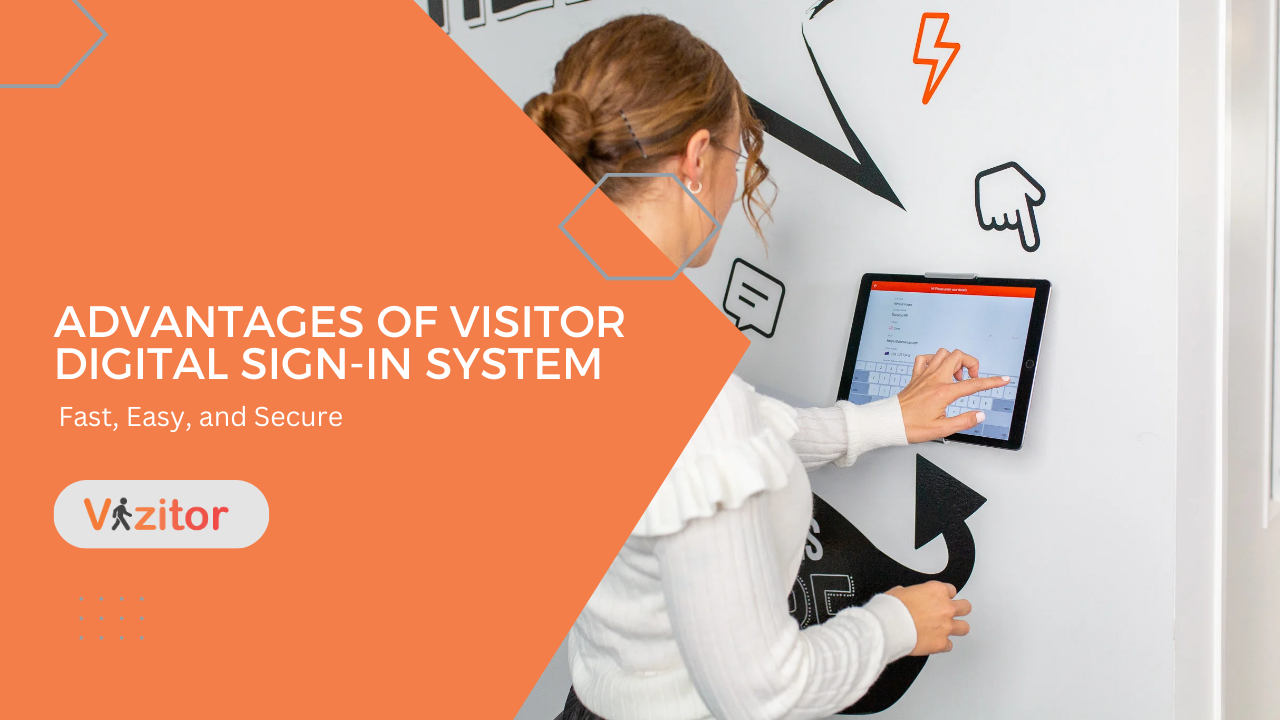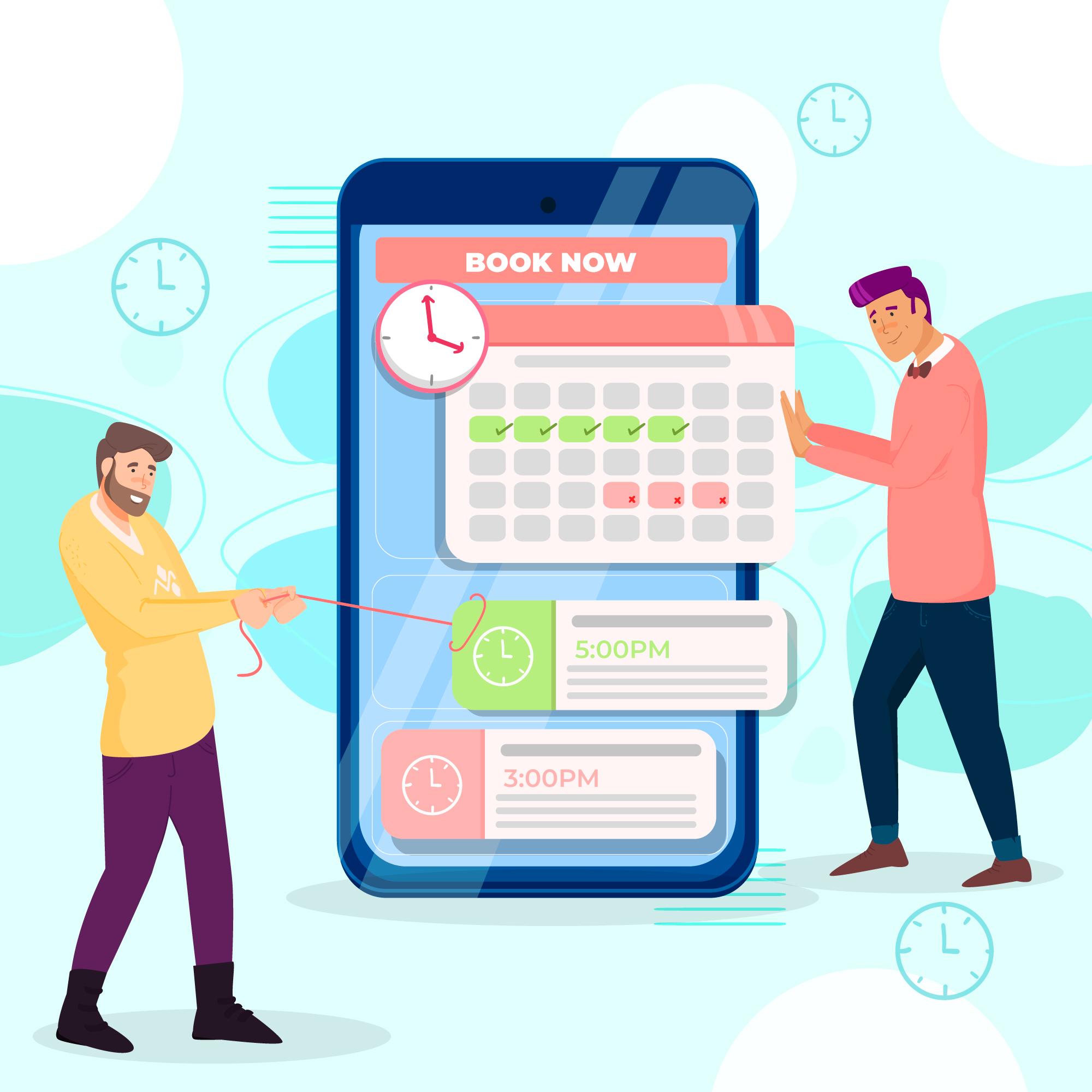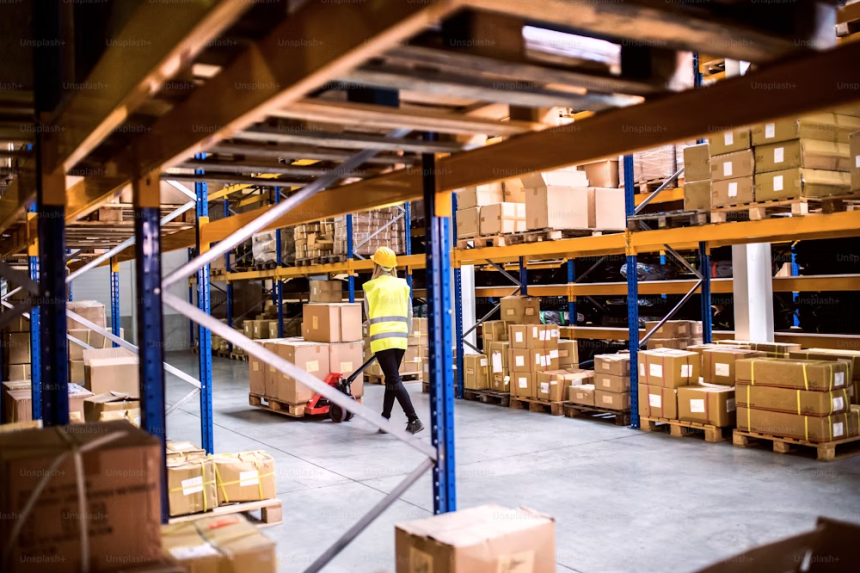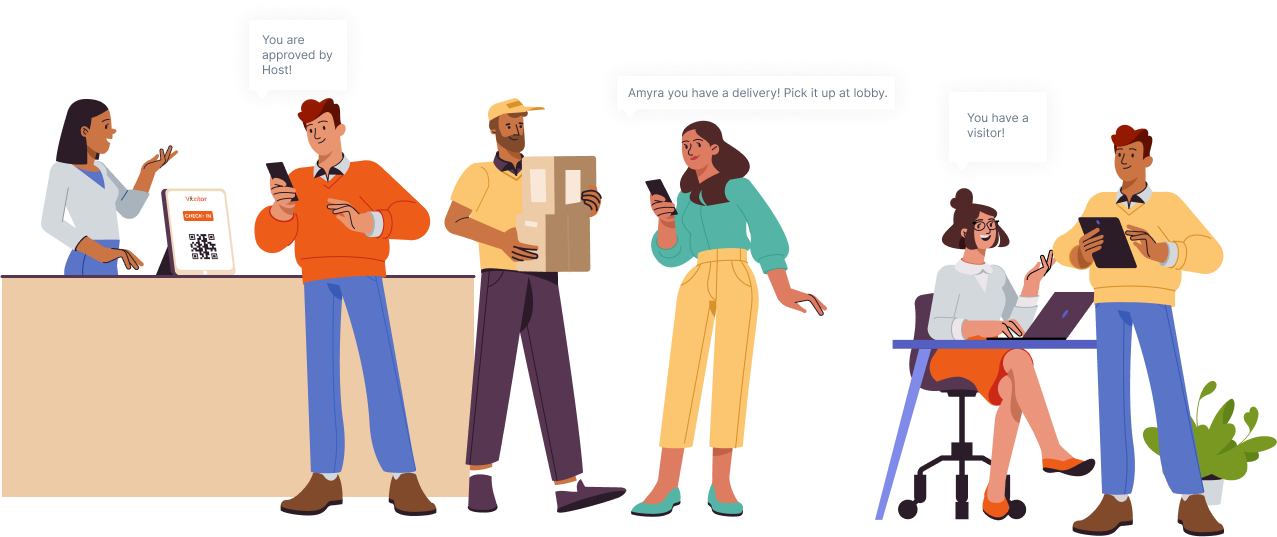Table of Content
Try Vizitor for Free!

Fri, Sep 6, 2024
Read in 12 minutes
Introduction
Did you know that businesses using digital sign-in systems for visitors report up to a 50% reduction in check-in times? A Visitor Digital Sign-In System is transforming how organizations manage guest arrivals, enhancing both efficiency and security.
A Visitor Digital Sign-In System is an advanced solution that replaces traditional paper logbooks with a streamlined, electronic process. When guests arrive, they can quickly check in using a touchscreen or tablet. This system automatically records their details, such as name, contact information, and the person they are visiting, without the need for manual entry.
One of the key benefits of digital sign-in system is their ability to enhance security. The system can capture visitor photos, issue digital badges, and track who is on-site in real-time. This reduces the risk of unauthorized access and ensures that only registered guests are allowed entry. Additionally, it provides a digital trail for audit purposes, which can be invaluable for compliance and emergency situations.
Moreover, digital sign-in systems often integrate with other security systems, such as access control and emergency notification systems, creating a comprehensive security network. They also streamline the check-in process, reducing wait times and improving the overall visitor experience.
By adopting a Visitor Digital Sign-In System, businesses not only improve their operational efficiency but also make a positive impression on visitors through modern and efficient processes. It’s a smart investment for any organization looking to enhance security and streamline guest management.
What Is Visitor Digital Sign in System?
A Visitor Digital Sign-In System is an advanced tool used to manage guest arrivals at a business or organization. Unlike traditional paper logbooks, this system uses electronic devices such as touchscreens or tablets to handle the check-in process.
How It Works
When visitors arrive, they interact with the digital sign-in system to register their presence. They input their personal details, such as name and contact information, and specify who they are meeting. Some systems also take a photograph of the visitor for added security. The information is then electronically recorded and stored in a database.
Key Features
- Real-Time Tracking: The system provides instant updates on who is currently on-site, allowing staff to know exactly who is in the building at any given time.
- Instant Notifications: Once a visitor has checked in, the system can send immediate notifications to the host, letting them know their guest has arrived.
- Digital Badges: Visitors often receive a digital badge or pass, which can be displayed on their smartphone or printed on-site. This badge usually includes the visitor’s name and the host they are visiting.
- Integration Capabilities: Many digital sign-in systems can integrate with existing security and access control systems, helping to create a more cohesive security infrastructure.
How to Tell If Your Business Needs a Visitor Management System
A Visitor Management System (VMS) can significantly enhance how your business handles guest check-ins and security. Here’s how to determine if your business could benefit from implementing one.
High Volume of Visitors
If your business receives a large number of visitors regularly—whether clients, suppliers, or guests—a visitor sign in system can streamline the check-in process. It helps manage multiple visitors efficiently, reducing wait times and preventing bottlenecks at the front desk.
Security Concerns
Security is a crucial aspect of managing a business. If you are worried about unauthorized access or need to improve visitor tracking, a VMS can help. It allows for the electronic recording of visitor details, such as their name, contact information, and photo, which enhances security. Additionally, it can integrate with other security systems to provide a comprehensive security solution.
Compliance Requirements
Certain industries have strict compliance and audit requirements. If your business falls into this category, a Visitor Management System can simplify record-keeping and ensure you meet these requirements. The system maintains an electronic log of all visitors, which can be easily accessed for audits and regulatory checks.
Inefficient Manual Processes
If your current visitor check-in process involves manual paperwork or a traditional logbook, it might be time to upgrade. A visitor sign in replaces cumbersome paperwork with a digital process, which can improve efficiency and reduce errors. It speeds up the check-in process and minimizes administrative tasks for your staff.
Poor Visitor Experience
The experience of your visitors can impact their perception of your business. If visitors often encounter long wait times or find the check-in process confusing, a VMS can enhance their experience. It provides a modern, user-friendly interface that makes checking in quick and straightforward, leaving a positive impression on guests.
Integration with Other Systems
If your business uses other digital systems for managing operations—like access control or appointment scheduling—a VMS can integrate with these systems to create a more cohesive workflow. Integration ensures that visitor data is synchronized across different platforms, improving overall efficiency.
Emergency Preparedness
In case of emergencies, knowing who is in your building can be critical. A VMS provides real-time updates on visitor presence, allowing you to quickly identify and account for everyone on-site. This capability is essential for effective emergency response and evacuation procedures.
Top 20 Advantages of Visitor Digital Sign-In System
A Visitor Digital Sign-In System offers numerous benefits that can greatly enhance the efficiency and security of visitor management in any organization. Here are the top 20 advantages:
1. Faster Check-In Process
Visitors can quickly check in using a digital interface, reducing wait times and improving the overall efficiency of the check-in process.
2. Enhanced Security
Digital systems capture visitor information such as names and photos, helping to ensure that only authorized individuals gain access to the premises.
3. Real-Time Visitor Tracking
The system provides real-time updates on who is currently on-site, allowing staff to monitor visitor activity and manage their presence more effectively.
4. Reduced Administrative Work
By automating the check-in process, a digital sign-in system reduces the need for manual paperwork and administrative tasks, freeing up staff time for other duties.
5. Improved Visitor Experience
Visitors benefit from a streamlined and user-friendly check-in process, which can create a more positive impression of the organization.
6. Automatic Notifications
The system can automatically notify hosts when their visitors arrive, ensuring that they are promptly greeted and attended to.
7. Integration with Other Systems
Many digital sign-in systems can integrate with existing security and access control systems, creating a cohesive and comprehensive security network.
8. Digital Record Keeping
The system maintains an electronic log of all visitors, which can be easily accessed for audits, compliance checks, and historical reference.
9. Compliance with Regulations
A digital sign-in system helps meet industry regulations and compliance requirements by providing accurate and accessible visitor records.
10. Customizable Check-In Process
Organizations can customize the sign-in process to collect specific information required for their operations or security needs.
11. Enhanced Emergency Preparedness
In case of an emergency, real-time data on who is in the building helps ensure that all visitors can be accounted for and evacuated safely.
12. Visitor Data Analysis
The system can generate reports and analytics on visitor patterns, which can be useful for improving security measures and operational efficiency.
13. Reduced Risk of Lost or Misplaced Logs
Unlike paper logbooks, digital records are less likely to be lost or misplaced, ensuring that visitor information is always available and accurate.
14. Environmentally Friendly
By reducing the need for paper, a digital sign-in system supports eco-friendly practices and helps reduce the organization’s environmental footprint.
15. Visitor Badging
The system can issue digital badges or printed visitor passes, which can be easily scanned for access control and identification purposes.
16. Support for Multiple Locations
For businesses with multiple offices or branches, a digital sign-in system can be used across various locations, providing consistent visitor management.
17. Enhanced Data Security
Digital systems offer advanced security features for protecting visitor data, such as encryption and secure storage, reducing the risk of data breaches.
18. Reduced Human Error
Automation minimizes the risk of errors that can occur with manual check-in processes, ensuring that visitor information is recorded accurately.
19. Professional Appearance
A digital sign-in system conveys a modern and professional image, which can positively influence visitors’ perceptions of the organization.
20. Scalability
As your business grows, a digital sign-in system can easily scale to accommodate increasing visitor volumes and additional locations without significant changes to the process.
How Will Vizitor Help You?
Vizitor is a leading Visitor Management System designed to modernize and streamline the way organizations handle visitor check-ins. With a focus on enhancing security, efficiency, and overall visitor experience, Vizitor offers a range of features that cater to various business needs.
Seamless Onboarding
Vizitor simplifies the onboarding process for both visitors and staff. New visitors can quickly learn how to use the system through an easy-to-follow interface, while staff receive training and support to ensure smooth operation from day one. This seamless onboarding reduces the learning curve and ensures that the system is utilized effectively from the start.
Custom Branding
Vizitor allows businesses to customize the sign-in interface with their own branding elements. This means you can incorporate your company’s logo, colors, and messaging into the digital check-in process. Custom branding helps reinforce your company’s image and creates a consistent and professional experience for visitors.
Advanced Analytics and Reporting
Vizitor provides advanced analytics and reporting features that offer insights into visitor patterns and behaviors. You can generate reports on visitor trends, peak times, and other key metrics. This data is valuable for making informed decisions about resource allocation, security measures, and improving visitor management strategies.
Contactless Check-In
In response to the growing demand for health and safety measures, Vizitor supports contactless check-in. Visitors can use their smartphones to check in via QR codes or other contactless methods, minimizing physical interaction and enhancing hygiene protocols.
Integration with Scheduling Systems
Vizitor integrates with various scheduling and appointment systems, allowing for a more coordinated visitor management experience. Integration ensures that visitor details and appointments are synchronized, reducing the likelihood of scheduling conflicts and improving overall efficiency.
Visitor Self-Service
Vizitor offers self-service options that allow visitors to manage their own check-ins, including printing badges or accessing visitor information without direct staff intervention. This self-service capability not only speeds up the check-in process but also reduces the workload on your reception staff.
Multi-Language Support
For businesses with a diverse clientele or international visitors, Vizitor provides multi-language support. This feature ensures that the system is accessible to visitors speaking different languages, making the check-in process more inclusive and user-friendly.
Remote Visitor Management
Vizitor allows for remote visitor management, which means you can oversee and manage visitor activity from anywhere. This feature is particularly useful for businesses with multiple locations or those that require off-site management capabilities.
Customizable Alerts and Notifications
With Vizitor, you can set up customizable alerts and notifications based on specific triggers or visitor actions. For example, you can receive alerts if a VIP guest arrives or if there are any issues with the check-in process. Customizable alerts help ensure that important events are promptly addressed.
Frequently Asked Questions
1. What is the Vizitor Digital Sign-In System?
The Vizitor Digital Sign-In System is a modern solution designed to manage visitor check-ins electronically. It replaces traditional paper logs with a digital interface, making the check-in process faster, more secure, and more efficient.
2. How does the Vizitor Digital Sign-In System work?
Visitors use a touchscreen or tablet to sign in, providing their details and optionally taking a photo. The system records this information in real-time and can issue digital badges or passes for identification.
3. What are the key features of Vizitor’s Digital Sign-In System?
Key features include real-time visitor tracking, customizable check-in screens, integration with security systems, digital badge issuance, and automatic notifications to hosts.
4. How does Vizitor improve security?
Vizitor enhances security by capturing and storing visitor information such as names, photos, and contact details. It also provides real-time updates on who is on-site, helping to ensure that only authorized individuals access your premises.
5. Can the Vizitor system integrate with existing security systems?
Yes, Vizitor can integrate with various existing security systems, including access control and emergency notification systems. This integration helps create a cohesive security network.
6. Is Vizitor’s sign-in process contactless?
Vizitor supports contactless check-in options, allowing visitors to use their smartphones to check in via QR codes or other methods. This reduces physical contact and enhances hygiene protocols.
7. Can Vizitor be customized for my business?
Yes, Vizitor offers customization options, including the ability to incorporate your company’s branding elements and adjust the sign-in process to fit specific requirements.
8. What type of visitor data does Vizitor collect and store?
Vizitor collects and stores visitor details such as names, photos, contact information, and the purpose of their visit. This data is securely stored and can be accessed for audits and compliance purposes.
9. How does Vizitor handle emergencies?
In emergencies, Vizitor provides real-time data on all visitors currently on-site, helping to ensure that everyone can be accounted for and safely evacuated if needed.
10. Does Vizitor support multiple languages?
Yes, Vizitor supports multiple languages, making it accessible to visitors who speak different languages and improving the inclusivity of the check-in process.
11. How can Vizitor help improve visitor experience?
Vizitor enhances the visitor experience by providing a fast, user-friendly check-in process, reducing wait times, and offering a modern and professional interface.
12. Can Vizitor generate reports and analytics?
Yes, Vizitor offers reporting and analytics features that provide insights into visitor patterns, peak times, and other metrics. This data helps in making informed decisions about visitor management and security.
13. What kind of support does Vizitor provide?
Vizitor offers comprehensive support, including onboarding assistance, training, and ongoing customer service to ensure that your team can effectively use the system.
14. How scalable is the Vizitor Digital Sign-In System?
Vizitor is highly scalable and can accommodate businesses of all sizes, from small offices to large enterprises with multiple locations.
15. How long does it take to implement Vizitor?
The implementation time for Vizitor depends on the complexity of your requirements and the size of your organization. Generally, it involves installation, configuration, and staff training, which can take from a few days to a couple of weeks.









